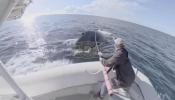ווידיאו וויאזוי מען כאפט ריזיגע פיש


OFF THE COAST OF AUSTRALIA — In a breathtaking display of marine hitchhiking, rare footage has captured sucker fish, known as remoras, “whale-surfing” on humpback whales in what scientists are calling one of the ocean’s most remarkable joyrides. The footage, recorded by marine researcher Olaf Meynecke of Griffith University’s Whales and Climate Research Program, shows the remoras peeling away from their massive hosts just moments before a breach — only to reattach themselves seconds later with flawless precision.
The video, taken from suction-cup cameras attached to migrating humpbacks, reveals dozens of these freeloading fish clinging to whales as they journey from Antarctica to the warmer waters off Queensland. Remoras, or *Remora australis*, use an adhesive plate on their heads to form a vacuum-like seal that allows them to attach securely to large marine animals, including whales, manta rays, and even scuba divers.
“They knew exactly when to let go before the whale breached the surface and returned to the same spot only seconds later,” Meynecke explained, describing the remoras’ uncanny ability to anticipate movement. He noted that while the relationship is considered symbiotic — the fish feed on the whale’s dead skin and parasites — his footage suggested that some whales find their companions irritating. “We’ve had individuals with high numbers of these remoras who seemed to breach repeatedly, possibly to shake them off,” he said.
Australia’s so-called “humpback highway” is a vital migratory route for an estimated 40,000 whales traveling over 10,000 kilometers each year. Yet scientists remain puzzled about how long the remoras stay aboard their hosts — and where they go when the whales head back to Antarctic waters. “They may switch hosts or find other large creatures to ride until the humpbacks return,” Meynecke added.
In the meantime, these opportunistic fish continue to fascinate researchers and ocean enthusiasts alike. Graceful, agile, and perfectly adapted to their upside-down lifestyle, the remoras’ breathtaking whale-surfing display stands as a testament to nature’s ingenuity — and to one of the ocean’s most extraordinary partnerships.
גאלערי
ווידעאס